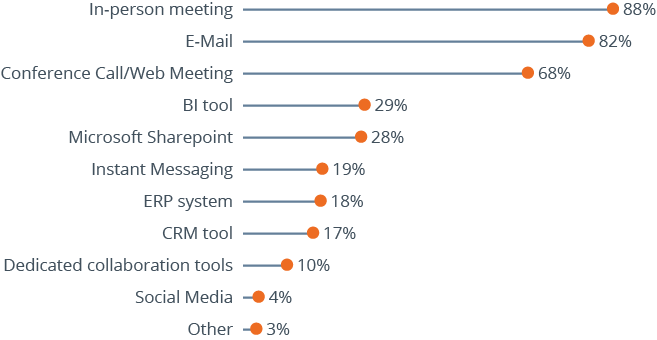We asked survey participants in our “Information Culture” study about collaboration in their organizations: where people collaborate and where it adds value in the decision-making process.
Direct, personal interactions via in-person meetings (88%) and conference calls/web meetings (68%) are two of the three most popular ways to collaborate. Using IT to collaborate is done primarily by E-Mail (82%) while all other software-based approaches are much less common.
With regard to business software, the most popular means of collaborating is via BI tools. It is interesting to see that BI software is more accessible for collaboration in business than Microsoft Sharepoint and other dedicated collaboration tools. Note that our findings relate to collaboration in business in general, not just in decision-making. Our impression is that the potential of BI tools is often overlooked when considering software to support collaboration in business and that BI tools should form a cornerstone of a collaboration strategy.
BI tools are particularly attractive for collaboration in mid-sized companies (35%). This market segment also makes more frequent use of ERP tools for collaboration (24%) than small (15%) or large companies (14%).
Dedicated collaboration tools are rarely used (10%), a seemingly poor reflection on the current availability and quality of collaboration software.
Little variation was found when we analyzed these findings by best-in-class status. The only notable difference was that best-in-class organizations use BI tools for collaboration much more than other companies.
Manufacturing companies are more likely to use their ERP and BI systems for collaboration.
Collaboration using BI software is far more widespread in Europe (35%) than in other regions.
We have noticed an increasing trend for collaborative functionality in BI software, and even in tools that are labeled as “collaborative BI”. Our survey reveals a clear order of decision support processes that could benefit from collaboration.
Our sample shows little appetite for more collaboration in reporting. However, there’s a much stronger feeling that collaboration adds value where data analysis is concerned. 67% of respondents agreed with this statement, and in larger companies, the figure was even higher (74%).
Planning and forecasting are collaborative by nature and, as expected, the majority of respondents (78%) believes that collaboration adds value to the process.
Information Culture Report
Leveraging the power of collective intelligence for better decision making
Request the free report now







